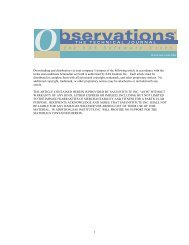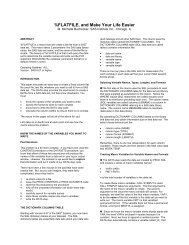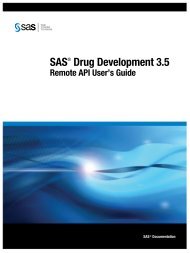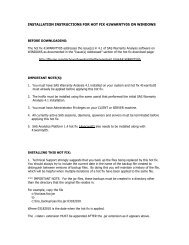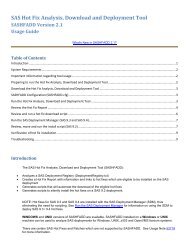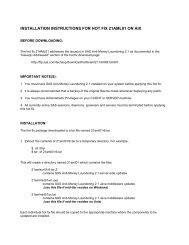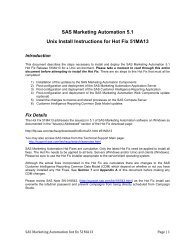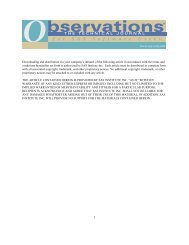ODS for Data Analysis: Output As-You-Like-It in Version 7 - Ftp Sas
ODS for Data Analysis: Output As-You-Like-It in Version 7 - Ftp Sas
ODS for Data Analysis: Output As-You-Like-It in Version 7 - Ftp Sas
You also want an ePaper? Increase the reach of your titles
YUMPU automatically turns print PDFs into web optimized ePapers that Google loves.
<strong>ODS</strong> <strong>for</strong> <strong>Data</strong> <strong>Analysis</strong>: <strong>Output</strong> <strong>As</strong>-<strong>You</strong>-<strong>Like</strong>-<strong>It</strong> <strong>in</strong> <strong>Version</strong> 7<br />
Christopher R. Ol<strong>in</strong>ger<br />
Randall D. Tobias<br />
SAS Institute Inc., Cary NC<br />
$EVWUDFW<br />
This paper discusses advances made <strong>in</strong> the output generated by all <strong>Version</strong> 7 SAS® Software procedures.<br />
New features provided by the <strong>Output</strong> Delivery System (<strong>ODS</strong>) <strong>in</strong>clude automatic render<strong>in</strong>g of procedure output<br />
<strong>in</strong> HTML <strong>for</strong> the web, rich-text, Postscript or PCL <strong>for</strong>mat, output data sets from any pr<strong>in</strong>ted output, and the<br />
ability to edit the look and feel of most output. <strong>ODS</strong> also supports all legacy l<strong>in</strong>e-mode pr<strong>in</strong>t<strong>in</strong>g and supports a<br />
document feature to allow post-procedure replay<strong>in</strong>g of output. This talk <strong>in</strong>troduces <strong>ODS</strong> features to be<br />
delivered <strong>in</strong> <strong>Version</strong> 7 and provides some concrete examples of how data analysts and statisticians can take<br />
advantage of the feature set provided by <strong>ODS</strong>.<br />
0RWLYDWLRQ<br />
Every SAS user knows and loves the list<strong>in</strong>g file, the vehicle <strong>for</strong> all pr<strong>in</strong>ted SAS output <strong>for</strong> more than two<br />
decades. While familiar, the list<strong>in</strong>g file has its limitations. For starters, output is restricted to monospace fonts<br />
only. On top of that, there isn’t any tab <strong>in</strong><strong>for</strong>mation <strong>in</strong> the list<strong>in</strong>g to let SAS users parse a table themselves.<br />
Industrious users have been <strong>for</strong>ced to use all sorts of tricks to get SAS output <strong>in</strong>to a document editor like<br />
Microsoft Word.<br />
The limitations of the SAS list<strong>in</strong>g stemmed from the fact that each procedure rendered its output to the list<strong>in</strong>g<br />
file one l<strong>in</strong>e at a time. This outputt<strong>in</strong>g technique made it virtually impossible to add new output dest<strong>in</strong>ations<br />
(like HTML and RTF) to the SAS System as each procedure was wed to its own <strong>in</strong>ternal pr<strong>in</strong>t rout<strong>in</strong>es. Add<strong>in</strong>g<br />
new output dest<strong>in</strong>ations would require each procedure to support the output dest<strong>in</strong>ation explicitly. One of the<br />
ma<strong>in</strong> goals of <strong>ODS</strong> was to get the statistical procedures out of the output <strong>for</strong>matt<strong>in</strong>g bus<strong>in</strong>ess — and, <strong>in</strong>deed,<br />
one of the nice th<strong>in</strong>gs about <strong>Version</strong> 7 <strong>ODS</strong> is that it completely removes the burden of add<strong>in</strong>g new output<br />
dest<strong>in</strong>ations from the procedures.<br />
However, the list<strong>in</strong>g file is handy <strong>for</strong> read<strong>in</strong>g as a flat file. In fact, it is too handy. Have you ever had to read a<br />
list<strong>in</strong>g file with a PROC PRINTTO and a _NULL_ DATA step just to rearrange some output or to grab some<br />
statistic that wasn’t on the output data set Did you ever th<strong>in</strong>k to yourself that there should be a better a way<br />
to do these sorts of th<strong>in</strong>gs<br />
Enter <strong>ODS</strong>. The follow<strong>in</strong>g table, generated by the RSREG procedure, was dropped <strong>in</strong>to this document with no<br />
<strong>in</strong>termediate translation. Other <strong>ODS</strong> features make it possible to create a data set directly from this piece of<br />
output.<br />
Factor DF Sum of Squares Mean Square F Value Pr > F<br />
Temperature 4 5258.016026 1314.504006 2.60 0.1613<br />
GasLiquidRatio 4 11045 2761.150641 5.46 0.0454<br />
Pack<strong>in</strong>gHeight 4 3813.016026 953.254006 1.89 0.2510<br />
Figure 1: RSREG output produced as RTF<br />
7KH 2'6 6ROXWLRQ<br />
<strong>ODS</strong> provides a more flexible mechanism <strong>for</strong> procedures to produce output. Instead of writ<strong>in</strong>g to the list<strong>in</strong>g file<br />
directly, the procedure creates an output object <strong>for</strong> each piece of output to be displayed. Every table, plot, and<br />
chart is thus a separate entity <strong>in</strong> the system. Each output object can be further broken down <strong>in</strong>to two<br />
component parts:<br />
• a data component, the collection of raw numbers and characters compris<strong>in</strong>g the contents of the output<br />
• a template component, the description of what the output is supposed to look like when the data is<br />
<strong>for</strong>matted and arranged on a page<br />
Each piece of output exists <strong>in</strong> a logical hierarchy of output directories that is created as your SAS job executes.<br />
For <strong>in</strong>stance, consider the follow<strong>in</strong>g example.<br />
1
data a;<br />
do a = 1 to 4;<br />
do b = 1 to 4;<br />
do c = 1 to 4;<br />
n = <strong>in</strong>t(6*ranuni(1));<br />
do i = 1 to n;<br />
y = a + b + rannor(1);<br />
x = a * b / rannor(3);<br />
output;<br />
end;<br />
end;<br />
end;<br />
end;<br />
end;<br />
run;<br />
proc glm data=a;<br />
class a b c;<br />
model x y = a|b|c / ss1 ;<br />
run;<br />
The output from the GLM procedure is arranged <strong>in</strong> the follow<strong>in</strong>g output directory structure. <strong>It</strong>ems <strong>in</strong> bold are<br />
directories and items <strong>in</strong> italics are output object names:<br />
GLM<br />
<strong>Data</strong><br />
Class Levels<br />
Number of Observations<br />
<strong>Analysis</strong> of Variance<br />
Dependent Variable X<br />
Overall ANOVA<br />
Fit Statistics<br />
Type I Model ANOVA<br />
Dependent Variable Y<br />
Overall ANOVA<br />
Fit Statistics<br />
Type I Model ANOVA<br />
Every piece of output that a procedure produces has a name, a label, and a directory path describ<strong>in</strong>g where<br />
the output resides <strong>in</strong> the directory structure.<br />
<strong>Output</strong> objects are created by the procedure, and they are rendered based on the output dest<strong>in</strong>ations that the<br />
user has requested. An output dest<strong>in</strong>ation describes the type of <strong>for</strong>matt<strong>in</strong>g requested <strong>for</strong> the output (HTML,<br />
RTF, and so <strong>for</strong>th). <strong>You</strong> can control which output dest<strong>in</strong>ations are <strong>in</strong> effect by us<strong>in</strong>g the <strong>ODS</strong> statement or by<br />
select<strong>in</strong>g output dest<strong>in</strong>ations <strong>in</strong> the SAS Explorer.<br />
Three new features af<strong>for</strong>d users control of <strong>ODS</strong> output: the <strong>ODS</strong> statement, the TEMPLATE procedure, and<br />
the <strong>ODS</strong> <strong>Output</strong> Document.<br />
• Us<strong>in</strong>g the <strong>ODS</strong> statement, you can set output dest<strong>in</strong>ation attributes, select or exclude <strong>in</strong>dividual pieces of<br />
output, request that pieces of output be turned <strong>in</strong>to a data set, and control which templates should be<br />
used <strong>for</strong> render<strong>in</strong>g purposes.<br />
• The TEMPLATE procedure enables you to specify the attributes that describe how a piece of output<br />
should be <strong>for</strong>matted, as well as specify stylistic elements <strong>for</strong> output dest<strong>in</strong>ations. <strong>You</strong> can specify cell<br />
<strong>for</strong>mats and headers, change column order<strong>in</strong>g, specify colors and fonts, add GIF images to HTML, and<br />
specify various other <strong>for</strong>matt<strong>in</strong>g and stylistic characteristics.<br />
• And, f<strong>in</strong>ally, there is support <strong>for</strong> a persistent <strong>for</strong>m of your output. The <strong>ODS</strong> <strong>Output</strong> Document enables you<br />
to save your output <strong>in</strong> raw <strong>for</strong>m, modify the appearance of a piece of output, and replay it to any output<br />
dest<strong>in</strong>ation. The Document also enables you to pick and choose <strong>in</strong>dividual pieces of output and comb<strong>in</strong>e<br />
2
them <strong>in</strong>to more complex reports. <strong>You</strong> can do all of this without rerunn<strong>in</strong>g the procedure that <strong>in</strong>itially<br />
created the output.<br />
'HWDLOV<br />
All procedures have been converted to produce their output as <strong>ODS</strong> output objects. 1 <strong>You</strong> can control these<br />
objects and <strong>in</strong>teract with <strong>ODS</strong> <strong>in</strong> a variety of ways. The primary ways to <strong>in</strong>teract with the system are through<br />
the <strong>ODS</strong> statement, the SAS Explorer, PROC TEMPLATE, and PROC OUTPUT.<br />
7KH 2'6 6WDWHPHQW<br />
The <strong>ODS</strong> statement is a global statement that enables you to control <strong>ODS</strong> <strong>in</strong> batch mode. Us<strong>in</strong>g the <strong>ODS</strong><br />
statement, you can specify options <strong>for</strong> output dest<strong>in</strong>ations, control the templates that are <strong>in</strong> effect <strong>for</strong> your SAS<br />
job, and select and exclude various pieces of output. <strong>You</strong> can also use the <strong>ODS</strong> statement to display the<br />
names of <strong>in</strong>dividual pieces of output as they are generated.<br />
2XWSXW 'HVWLQDWLRQV<br />
Each output dest<strong>in</strong>ation generates a particular type of output. HTML, output data sets, and Postscript are all<br />
separate output dest<strong>in</strong>ations. <strong>ODS</strong> is designed to allow multiple output dest<strong>in</strong>ations to be active at the same<br />
time. A s<strong>in</strong>gle SAS job can, there<strong>for</strong>e, create both HTML and the SAS list<strong>in</strong>g concurrently.<br />
The <strong>in</strong>itial release of <strong>Version</strong> 7 will conta<strong>in</strong> support <strong>for</strong> the follow<strong>in</strong>g output dest<strong>in</strong>ations:<br />
• the standard SAS list<strong>in</strong>g<br />
• HTML <strong>for</strong> the Web<br />
• output data sets<br />
Soon after the <strong>in</strong>itial release of <strong>Version</strong> 7, SAS Institute will be releas<strong>in</strong>g support <strong>for</strong> the follow<strong>in</strong>g output<br />
dest<strong>in</strong>ations:<br />
• the <strong>ODS</strong> <strong>Output</strong> Document <strong>for</strong> modify<strong>in</strong>g and replay<strong>in</strong>g output without rerunn<strong>in</strong>g the procedure that<br />
created it<br />
• RTF <strong>for</strong> <strong>in</strong>clusion <strong>in</strong> Microsoft Word<br />
• PS and PCL <strong>for</strong> high fidelity pr<strong>in</strong>ters<br />
• possibly SGML and LaTex<br />
<strong>You</strong> select an output dest<strong>in</strong>ation by specify<strong>in</strong>g the appropriate <strong>ODS</strong> statement options be<strong>for</strong>e your SAS job is<br />
executed. <strong>As</strong> an example, consider the follow<strong>in</strong>g statements that compute a response surface regression<br />
analysis and render the results as RTF. The table produced by this job is <strong>in</strong>cluded at the start of this paper<br />
(Figure 1).<br />
ods rtf file='example.rtf' ;<br />
ods select factorANOVA;<br />
data a;<br />
<strong>in</strong>put Odor Temperature GasLiquidRatio Pack<strong>in</strong>gHeight @@;<br />
datal<strong>in</strong>es;<br />
66 -1 -1 0 39 1 -1 0 43 -1 1 0 49 1 1 0<br />
58 -1 0 -1<br />
65 0 -1 -1<br />
17 1<br />
7 0<br />
0 -1<br />
1 -1<br />
-5 -1 0 1<br />
43 0 -1 1<br />
-40 1 0 1<br />
-22 0 1 1<br />
-31 0 0 0 -35 0 0 0 -26 0 0 0<br />
run;<br />
proc rsreg;<br />
model odor=Temperature GasLiquidRatio Pack<strong>in</strong>gHeight;<br />
run;<br />
ods rtf close;<br />
See the “Examples” section <strong>for</strong> some examples of other output dest<strong>in</strong>ations.<br />
Trac<strong>in</strong>g and Select<strong>in</strong>g <strong>Output</strong><br />
<strong>You</strong> may have noticed <strong>in</strong> the previous example that you can select and exclude <strong>in</strong>dividual pieces of output with<br />
the <strong>ODS</strong> statement. Each piece of output has associated with it a name, a label, a directory path, and a<br />
1 Some procedures are more <strong>ODS</strong> compliant than others. The PLOT procedure, <strong>for</strong> <strong>in</strong>stance, does not<br />
separate data and template <strong>in</strong><strong>for</strong>mation. <strong>It</strong> relies on what is known as “batch mode” - the old SAS list<strong>in</strong>g is<br />
captured and passed along as the output object’s data.<br />
3
template path. <strong>You</strong> can display this <strong>in</strong><strong>for</strong>mation by us<strong>in</strong>g the <strong>ODS</strong> TRACE option. Once you know the name or<br />
label of a piece of output, you can select it, exclude it, or turn it <strong>in</strong>to a SAS data set. See the “Examples”<br />
section <strong>for</strong> a demonstration.<br />
7KH 6$6 ([SORUHU<br />
The SAS Explorer is a new feature <strong>in</strong> the <strong>Version</strong> 7 SAS Display Manager that enables you to explore the<br />
various pieces and parts of the SAS System. Part of the SAS Explorer is the RESULTS node. The RESULTS<br />
node reta<strong>in</strong>s a runn<strong>in</strong>g record of the output directory hierarchy that is produced when a SAS job is executed.<br />
Figure 2 shows the Explorer with the results <strong>for</strong> an analysis of variance. By click<strong>in</strong>g on the output labels <strong>in</strong> the<br />
Explorer you can l<strong>in</strong>k directly to the output <strong>in</strong> the output w<strong>in</strong>dow or <strong>in</strong> an HTML browser. The items on the lefthand<br />
side of the RESULTS node are output directories. The items on the right-hand side of the RESULTS<br />
node are pieces of output (tables <strong>in</strong> this case).<br />
The Explorer also enables you to set <strong>ODS</strong> options and edit templates. All of the options available <strong>in</strong> the <strong>ODS</strong><br />
statement can be set from the Explorer. The template editor is a dialogue-based editor that allows you to set<br />
values <strong>for</strong> all of the template options.<br />
Figure 2: The SAS Explorer<br />
The Template Procedure<br />
A template is an abstract description of what a piece of output is supposed to look like when it is <strong>for</strong>matted. A<br />
template conta<strong>in</strong>s attributes describ<strong>in</strong>g column order<strong>in</strong>g, style <strong>in</strong><strong>for</strong>mation, justification, cell <strong>for</strong>mats, and other<br />
<strong>for</strong>matt<strong>in</strong>g characteristics. Most output objects have a template associated with them. <strong>You</strong> can f<strong>in</strong>d the<br />
template associated with a particular piece of output by look<strong>in</strong>g at the <strong>ODS</strong> TRACE record. For an example,<br />
please see Figure 8.<br />
The TEMPLATE procedure enables you to create and edit templates <strong>in</strong> batch mode. Templates are fully<br />
editable, so you can change the appearance of most output <strong>in</strong> the system. <strong>You</strong> can edit a template <strong>in</strong> Display<br />
Manager mode by us<strong>in</strong>g the new SAS Explorer.<br />
SAS System templates are stored <strong>in</strong> the SASHELP library. When you run PROC TEMPLATE to modify or edit<br />
a template, the template is stored <strong>in</strong> the SASUSER library. <strong>You</strong> can modify the concatenation path that <strong>ODS</strong><br />
uses to look up templates with the <strong>ODS</strong> PATH statement. In this manner you can set up a default set of<br />
templates <strong>for</strong> your organization to use that modifies the look and feel of SAS output. Once you have edited a<br />
template <strong>for</strong> a piece of output, the output cont<strong>in</strong>ues to use that template until the template is deleted.<br />
For an example of edit<strong>in</strong>g and us<strong>in</strong>g templates, please see the “Examples” section.<br />
6W\OHV<br />
A style template is mostly concerned with stylistic issues such as colors, fonts, and presentation attributes. A<br />
style can be specified only <strong>for</strong> output dest<strong>in</strong>ations that support them. At present, the only dest<strong>in</strong>ations that<br />
4
support styles are HTML, RTF, and PS/PCL. The SAS output w<strong>in</strong>dow does not participate <strong>in</strong> the style scheme,<br />
so if you want to use styles you need to use an output dest<strong>in</strong>ation that fully supports them.<br />
<strong>It</strong> is important to note the difference between a style template and a normal table template. A style applies to<br />
an entire SAS job, and a table template applies only to the tables that reference the template. Use of styles<br />
ensures a consistent look and feel across all output from the SAS System. <strong>You</strong> can, however, reference style<br />
<strong>in</strong><strong>for</strong>mation <strong>in</strong> templates <strong>for</strong> <strong>in</strong>dividual headers and data cells.<br />
<strong>You</strong> can specify a style to use <strong>for</strong> an output dest<strong>in</strong>ation us<strong>in</strong>g the <strong>ODS</strong> statement. <strong>As</strong> an example of what you<br />
can do with styles, see the PROC TABULATE output <strong>in</strong> Figure 3.<br />
Figure 3: PROC TABULATE example us<strong>in</strong>g styles<br />
7KH 2'6 2XWSXW 'RFXPHQW<br />
Have you ever wanted to re<strong>for</strong>mat output from a procedure without actually hav<strong>in</strong>g to rerun the procedure If<br />
so then the Document is <strong>for</strong> you. The Document is a persistent representation of the output that is produced by<br />
your SAS job. <strong>Output</strong> is stored completely <strong>in</strong> raw <strong>for</strong>m. This enables you to change <strong>for</strong>matt<strong>in</strong>g characteristics<br />
(<strong>for</strong>mats, column headers, and so on) without rerunn<strong>in</strong>g the procedure that created the output. The Document<br />
also enables you to browse and modify SAS output from previous runs, comb<strong>in</strong>e output <strong>in</strong>to custom reports,<br />
and access your output from client-server applications.<br />
The OUTPUT Procedure<br />
The OUTPUT procedure enables you to manipulate <strong>ODS</strong> <strong>Output</strong> Documents <strong>in</strong> batch mode. There are<br />
commands to reorder output <strong>in</strong> the output directory hierarchy, to move and copy output to new directories, and<br />
to replay output to the various <strong>ODS</strong> output dest<strong>in</strong>ations. For Display Manager users, there is support <strong>for</strong><br />
manag<strong>in</strong>g <strong>Output</strong> Documents <strong>in</strong> the SAS Explorer. All of the functionality <strong>in</strong> PROC OUTPUT will be available <strong>in</strong><br />
the Explorer.<br />
Examples<br />
Us<strong>in</strong>g <strong>Output</strong> Delivery <strong>in</strong> a Pharmaceutical Trial<br />
Introduction<br />
This example uses a pre-cl<strong>in</strong>ical drug experiment to demonstrate how <strong>ODS</strong> gives you unprecedented control<br />
over SAS output. The data is taken from Cole and Grizzle (1966). In order to study the effect of two different<br />
5
drugs on histam<strong>in</strong>e levels <strong>in</strong> the blood, the drugs were given to 13 animals, some with depleted histam<strong>in</strong>e<br />
levels, and the levels of histam<strong>in</strong>e <strong>in</strong> the animals' blood was measured after 0, 1, 3, and 5 m<strong>in</strong>utes. The<br />
response variable is the logarithm of the histam<strong>in</strong>e level. The follow<strong>in</strong>g statements create a SAS data set<br />
named HISTAMINE that conta<strong>in</strong>s the experimental data.<br />
title "Histam<strong>in</strong>e Study";<br />
data Histam<strong>in</strong>e;<br />
<strong>in</strong>put Drug $12. Depleted $ hist0 hist1 hist3 hist5;<br />
logHist0 = log(hist0); logHist1 = log(Hist1);<br />
logHist3 = log(hist3); logHist5 = log(Hist5);<br />
datal<strong>in</strong>es;<br />
Morph<strong>in</strong>e N .04 .20 .10 .08<br />
Morph<strong>in</strong>e N .02 .06 .02 .02<br />
Morph<strong>in</strong>e N .07 1.40 .48 .24<br />
Morph<strong>in</strong>e N .17 .57 .35 .24<br />
Morph<strong>in</strong>e Y .10 .09 .13 .14<br />
Morph<strong>in</strong>e Y .07 .07 .06 .07<br />
Morph<strong>in</strong>e Y .05 .07 .06 .07<br />
Trimethaphan N .03 .62 .31 .22<br />
Trimethaphan N .03 1.05 .73 .60<br />
Trimethaphan N .07 .83 1.07 .80<br />
Trimethaphan N .09 3.13 2.06 1.23<br />
Trimethaphan Y .10 .09 .09 .08<br />
Trimethaphan Y .08 .09 .09 .10<br />
Trimethaphan Y .13 .10 .12 .12<br />
Trimethaphan Y .06 .05 .05 .05<br />
;<br />
The appropriate analysis <strong>for</strong> this type of experiment is a repeated measures analysis, which assumes that<br />
responses from different animals are <strong>in</strong>dependent but responses at different times <strong>for</strong> the same animal are<br />
correlated. The follow<strong>in</strong>g statements use PROC GLM to per<strong>for</strong>m a repeated measures analysis, nam<strong>in</strong>g the<br />
drug and depletion status as between-subject factors <strong>in</strong> the MODEL statement, and nam<strong>in</strong>g postadm<strong>in</strong>istration<br />
measurement time as the with<strong>in</strong>-subject factor. (For more <strong>in</strong><strong>for</strong>mation on this study and its<br />
analysis, see Example 7 <strong>in</strong> the GLM chapter of the SAS/STAT® documentation.)<br />
proc glm data=Histam<strong>in</strong>e;<br />
class Drug Depleted;<br />
model LogHist0—LogHist5 = Drug Depleted Drug*Depleted / nouni;<br />
repeated Time 4 (0 1 3 5) polynomial / summary pr<strong>in</strong>te;<br />
quit;<br />
Deliver<strong>in</strong>g <strong>Output</strong> on the Web<br />
Repeated measures analyses produce a lot of output, <strong>in</strong>clud<strong>in</strong>g univariate and multivariate ANOV<strong>As</strong>,<br />
correlation matrices, with<strong>in</strong>- and between-subject tests, and so on. In this case, the output starts with the class<br />
level <strong>in</strong><strong>for</strong>mation and goes on <strong>for</strong> over 200 l<strong>in</strong>es on five or six pages. So your first question might be: “How can<br />
I get all that output to my colleagues without hav<strong>in</strong>g to put all those pages <strong>in</strong> the mail” <strong>ODS</strong> provides the<br />
answer: you can produce the GLM output directly as HTML and put it on your company's <strong>in</strong>tranet. All you have<br />
to do is name the file where you want the HTML to be written, as shown <strong>in</strong> the follow<strong>in</strong>g statements:<br />
ods html body = 'HistGLM.html';<br />
proc glm data=Histam<strong>in</strong>e;<br />
class Drug Depleted;<br />
model LogHist0--LogHist5 = Drug Depleted Drug*Depleted / nouni;<br />
repeated Time 4 (0 1 3 5) polynomial / summary pr<strong>in</strong>te;<br />
quit;<br />
ods html close;<br />
The ods html body= option specifies the file where the HTML output is to be written, and the ods html<br />
close option directs the system to stop writ<strong>in</strong>g HTML. The results use HTML's built-<strong>in</strong> table <strong>for</strong>matt<strong>in</strong>g<br />
facilities to make output that looks right on any browser (Figure 4).<br />
6
Figure 4: HTML output <strong>for</strong> GLM repeated measures analysis<br />
%HFDXVH WKHUH DUH VR PDQ\ WDEOHV WR PDNH VHQVH RI D WDEOH RI FRQWHQWV ZRXOG EH KHOSIXO )RUWXQDWHO\ 2'6<br />
FDQ SURGXFH WKDW WRR -XVW QDPH DQRWKHU ILOH WR FRQWDLQ WKH WDEOH RI FRQWHQWV, as shown <strong>in</strong> the follow<strong>in</strong>g<br />
statements:<br />
ods html body = 'HistGLM.html'<br />
contents = 'HistGLMContents.html';<br />
proc glm data=Histam<strong>in</strong>e;<br />
class Drug Depleted;<br />
model LogHist0--LogHist5 = Drug Depleted Drug*Depleted / nouni;<br />
repeated Time 4 (0 1 3 5) polynomial / summary pr<strong>in</strong>te;<br />
quit;<br />
ods html close;<br />
7KH UHVXOWLQJ :HE SDJH )LJXUH FRQWDLQV D URDG PDS IRU WKH */0 RXWSXW<br />
7
Figure 5: HTML table of contents <strong>for</strong> GLM repeated measures analysis<br />
0RUHRYHU WKH FRQWHQWV DUH OLQNHG WR WKH ERG\ RI WKH RXWSXW 7KDW LV LI \RX FOLFN RQ ³6SKHULFLW\ 7HVWV´ \RXU<br />
EURZVHU WDNHV \RX ULJKW WR WKH WHVW IRU D VSKHULFDO FRYDULDQFH VWUXFWXUH EHWZHHQ WKH ZLWKLQVXEMHFW<br />
PHDVXUHPHQWV )LJXUH Note that the sphericity tests are significant, <strong>in</strong>dicat<strong>in</strong>g that you should use the<br />
multivariate tests <strong>for</strong> with<strong>in</strong>-subject effects. <strong>You</strong> can even make a Web page that displays the contents and the<br />
body of the output at the same time, us<strong>in</strong>g HTML fram<strong>in</strong>g, as demonstrated <strong>in</strong> the follow<strong>in</strong>g statements.<br />
ods html body = 'HistGLM.html'<br />
contents = 'HistGLMContents.html'<br />
frame = 'HistGLMFrame.html';<br />
proc glm data=Histam<strong>in</strong>e;<br />
class Drug Depleted;<br />
model LogHist0--LogHist5 = Drug Depleted Drug*Depleted / nouni;<br />
repeated Time 4 (0 1 3 5) polynomial / summary pr<strong>in</strong>te;<br />
quit;<br />
ods html close;<br />
The result<strong>in</strong>g Web page is shown <strong>in</strong> Figure 7.<br />
8
Figure 6: Sphericity tests<br />
Figure 7: Comb<strong>in</strong>ed table of contents and repeated measures analysis<br />
9
'HOLYHULQJ -XVW WKH 2XWSXW
E = Error SS&CP Matrix<br />
S=1 M=0.5 N=3.5<br />
Statistic Value F Value Num DF Den DF Pr > F<br />
Wilks' Lambda 0.19383010 12.48 3 9 0.0015<br />
Pillai's Trace 0.80616990 12.48 3 9 0.0015<br />
Hotell<strong>in</strong>g-Lawley Trace 4.15915732 12.48 3 9 0.0015<br />
Roy's Greatest Root 4.15915732 12.48 3 9 0.0015<br />
<strong>Output</strong> Added:<br />
-------------<br />
Name: ModelANOVA<br />
Label: Type III Model ANOVA<br />
Template: stat.GLM.Tests<br />
Path: GLM.Repeated.BetweenSubjects.ModelANOVA<br />
-------------<br />
Histam<strong>in</strong>e Study<br />
General L<strong>in</strong>ear Models Procedure<br />
Repeated Measures <strong>Analysis</strong> of Variance<br />
Tests of Hypotheses <strong>for</strong> Between Subjects Effects<br />
Source DF Type III SS Mean Square F Value Pr > F<br />
Drug 1 5.99336243 5.99336243 2.71 0.1281<br />
Depleted 1 15.44840703 15.44840703 6.98 0.0229<br />
Drug*Depleted 1 4.69087508 4.69087508 2.12 0.1734<br />
Error 11 24.34683348 2.21334850<br />
Figure 8: List<strong>in</strong>g output with <strong>in</strong>terleaved TRACE OUTPUT results<br />
'HOLYHULQJ 2XWSXW WR 'DWD 6HWV<br />
7KH GLVSOD\HG RXWSXW PD\ VWLOO EH PRUH YHUERVH WKDQ \RX ZDQW
ods output Mtests<br />
= HistWith<strong>in</strong><br />
BetweenSubjects.ModelANOVA = HistBetween;<br />
proc glm data=Histam<strong>in</strong>e;<br />
class Drug Depleted;<br />
model LogHist0—LogHist5 = Drug Depleted Drug*Depleted / nouni;<br />
repeated Time 4 (0 1 3 5) polynomial / summary pr<strong>in</strong>te;<br />
quit;<br />
$OO WKH PXOWLYDULDWH WHVW UHVXOWV DSSHDU LQ WKH +,67:,7+,1 GDWD VHW 7KLV LV EHFDXVH DOO WKH PXOWLYDULDWH WHVW<br />
WDEOHV DUH QDPHG ³07HVWV DOWKRXJK WKH\ RFFXU LQ GLIIHUHQW GLUHFWRULHV LQ WKH RXWSXW GLUHFWRU\ KLHUDUFK\<br />
7KHUH DUH DOVR RWKHU WDEOHV QDPHG ³0RGHO$129$ EXW WKH DERYH VWDWHPHQW PDNHV VXUH \RX JHW RQO\ WKH<br />
EHWZHHQVXEMHFW $129$ LQ WKH +,67%(7:((1 GDWD VHW E\ DGGLWLRQDOO\ VSHFLI\LQJ WKH JURXS LQ ZKLFK LW<br />
RFFXUV<br />
'HOLYHULQJ &RPELQHG 2XWSXW<br />
So, now that you have the tests <strong>in</strong> data sets, how can you display all the <strong>in</strong><strong>for</strong>mation <strong>in</strong> one over-all summary<br />
table The follow<strong>in</strong>g statements show how to comb<strong>in</strong>e the two data sets <strong>in</strong>to a s<strong>in</strong>gle data set, dropp<strong>in</strong>g the<br />
row correspond<strong>in</strong>g to “Error” from the between-tests and renam<strong>in</strong>g a couple of variables <strong>in</strong> the with<strong>in</strong>-tests<br />
data set. Also, you reta<strong>in</strong> the results of just one of the four multivariate tests.<br />
data HistTests;<br />
set HistBetween(where =(Source ^= "Error") )<br />
HistWith<strong>in</strong> (rename=(Hypothesis = Source NumDF=DF)<br />
where =(Statistic = "Hotell<strong>in</strong>g-Lawley Trace"));<br />
run;<br />
1RZ \RX FDQ XVH WKH '$7$ VWHS WR DSSO\ D WHPSODWH WR WKH FRPELQHG WHVW GDWD $ WHPSODWH VSHFLILHV KRZ DQ<br />
DEVWUDFW UHFWDQJOH RI GDWD VKRXOG EH GLVSOD\HG ,Q WKH RXWSXW IURP WKH ods trace output VWDWHPHQW EHIRUH<br />
\RX VDZ WKDW HDFK WDEOH KDV D WHPSODWH DV ZHOO DV D QDPH ,Q SDUWLFXODU WKH WHPSODWH DVVRFLDWHG ZLWK WKH<br />
$129$ WDEOHV LV ³6WDW*/07HVWV /RRNLQJ DW )LJXUH \RX FDQ VHH WKDW WKH */0 SURFHGXUH XVHV WKLV WHPSODWH<br />
WR IRUPDW $129$ WDEOHV DQG \RX FDQ XVH LW WRR 6XSSRVH WKH FRPELQHG GDWD VHW LV QDPHG +,677(676 7KH<br />
IROORZLQJ VWDWHPHQWV ³UHQGHU WKLV GDWD VHW XVLQJ WKH ³6WDW*/07HVWV WHPSODWH<br />
data _null_;<br />
set HistTests;<br />
file pr<strong>in</strong>t ods=(template='Stat.GLM.Tests');<br />
put _ods_;<br />
run;<br />
7KH UHVXOWV ORRN MXVW OLNH DQ\ RWKHU $129$ WDEOH GLVSOD\HG E\ WKH */0 SURFHGXUH
The results are shown <strong>in</strong> Figure 9. The footnote expla<strong>in</strong>s why the with<strong>in</strong>-subject tests have miss<strong>in</strong>g SS and<br />
MS columns. For more <strong>in</strong><strong>for</strong>mation on how to use the DATA step to <strong>in</strong>terface with <strong>ODS</strong>, please refer to Heffner<br />
(1998).<br />
Figure 9: Comb<strong>in</strong>ed tests <strong>for</strong> with<strong>in</strong>- and between-subject effects<br />
'HOLYHULQJ &XVWRPL]HG 2XWSXW<br />
)RU KLVWRULFDO UHDVRQV WKH */0 SURFHGXUH GLVSOD\V VXPV RI VTXDUHV DQG PHDQ VTXDUHV ZLWK PDQ\ GLJLWV E\<br />
GHIDXOW 6XSSRVH WKDW \RX ZDQW WR GLVSOD\ WKHP ZLWK IHZHU GLJLWV ,W LV HDV\ WR UHGHILQH WKH IRUPDW XVHG WR<br />
GLVSOD\ D FROXPQ LQ D WHPSODWH )RU H[DPSOH WKH IROORZLQJ VWDWHPHQWV FRS\ WKH FXUUHQW ³6WDW*/07HVWV´<br />
WHPSODWH FKDQJLQJ WKH IRUPDW IRU SULQWLQJ WKHVH WZR FROXPQV<br />
proc template;<br />
edit Stat.GLM.Tests as Comb<strong>in</strong>edTests;<br />
edit SS; <strong>for</strong>mat=D7.3; end;<br />
edit MS; <strong>for</strong>mat=D7.3; end;<br />
end;<br />
run;<br />
<strong>You</strong> can apply this new template to the comb<strong>in</strong>ed test data <strong>in</strong> the same way that you applied the predef<strong>in</strong>ed<br />
template.<br />
title "Histam<strong>in</strong>e Study";<br />
footnote1<br />
"With<strong>in</strong>-subject tests are computed us<strong>in</strong>g Hotell<strong>in</strong>g-Lawley trace";<br />
ods html body = 'HistTests2.html';<br />
data _null_;<br />
set HistTests;<br />
file pr<strong>in</strong>t ods=(template='Comb<strong>in</strong>edTests');<br />
put _ods_;<br />
13
un;<br />
ods html close;<br />
title;<br />
footnote1;<br />
ods html close;<br />
The results are shown <strong>in</strong> Figure 10.<br />
Figure 10: Comb<strong>in</strong>ed tests with re<strong>for</strong>matted SS and MS columns<br />
To make the analysis really easy to <strong>in</strong>terpret, you'd like to emphasize effects that are significant at the 0.02<br />
level. This you can also do with the template used to display the results. The follow<strong>in</strong>g statements use the<br />
template to<br />
• redef<strong>in</strong>e the <strong>for</strong>mat <strong>for</strong> the SS and MS columns, as shown previously<br />
• <strong>in</strong>clude the table title and footnote <strong>in</strong> the body of the table<br />
• translate the miss<strong>in</strong>g values <strong>for</strong> SS and MS <strong>in</strong> the rows correspond<strong>in</strong>g to multivariate tests to asterisks,<br />
referr<strong>in</strong>g to the footnote<br />
• emphasize significant p-values with a bold font<br />
• add a column depict<strong>in</strong>g the level of significance<br />
proc template;<br />
def<strong>in</strong>e table Comb<strong>in</strong>edTests;<br />
parent=Stat.GLM.Tests;<br />
header "#Histam<strong>in</strong>e Study##";<br />
footer "#* - Test computed us<strong>in</strong>g Hotell<strong>in</strong>g-Lawley trace";<br />
column Source DF SS MS FValue ProbF Star;<br />
def<strong>in</strong>e SS;<br />
parent = Stat.GLM.SS;<br />
<strong>for</strong>mat = D7.3;<br />
14
translate _val_ = . <strong>in</strong>to ' *';<br />
end;<br />
def<strong>in</strong>e MS;<br />
parent = Stat.GLM.MS;<br />
<strong>for</strong>mat = D7.3;<br />
translate _val_ = . <strong>in</strong>to ' *';<br />
end;<br />
def<strong>in</strong>e ProbF;<br />
parent = Stat.GLM.ProbF;<br />
cellstyle _val_ < 0.02 as <strong>Data</strong>Emphasis;<br />
end;<br />
def<strong>in</strong>e Star;<br />
compute as ProbF;<br />
translate _val_ > 0.05 <strong>in</strong>to "",<br />
_val_ > 0.01 <strong>in</strong>to "*",<br />
_val_ > 0.001 <strong>in</strong>to "**",<br />
_val_
Figure 11: Comb<strong>in</strong>ed tests with special <strong>for</strong>matt<strong>in</strong>g<br />
8VLQJ 2XWSXW 'HOLYHU\ LQ DQ ,QGXVWULDO ([SHULPHQW<br />
,QWURGXFWLRQ<br />
7KH SUHFHGLQJ VHFWLRQV GHPRQVWUDWH KRZ \RX FDQ XVH 2'6 WR FXVWRPL]H PDQLSXODWH DQG GHOLYHU MXVW WKH 6$6<br />
SURFHGXUH RXWSXW \RX ZDQW GLUHFWO\ WR \RXU FROOHDJXHV 6R IDU WKH H[DPSOHV IRFXV RQ UHVXOWV WKDW FDQ EH<br />
VXPPDUL]HG LQ D VLQJOH WDEOH :KHQ VWDWLVWLFDO UHVXOWV DUH QHFHVVDULO\ PRUH FRPSOLFDWHG \RX FDQ XVH 2'6 WR<br />
OLQN GLIIHUHQW SDUWV WRJHWKHU
class Supplier Mach<strong>in</strong>e;<br />
model Defects = Supplier Mach<strong>in</strong>e;<br />
means Supplier Mach<strong>in</strong>e / tukey;<br />
quit;<br />
'HOLYHULQJ /LQNHG 2XWSXW<br />
The tables of <strong>in</strong>terest are the model ANOVA and the multiple comparisons output. <strong>You</strong> can l<strong>in</strong>k a row of the<br />
ANOVA table to the correspond<strong>in</strong>g multiple comparisons table with the follow<strong>in</strong>g template:<br />
proc template;<br />
edit Stat.GLM.Tests;<br />
edit Source;<br />
translate _val_ = "Supplier" <strong>in</strong>to<br />
' '||_val_||" ",<br />
_val_ = "Mach<strong>in</strong>e" <strong>in</strong>to<br />
' '||_val_||" ";<br />
end;<br />
end;<br />
run;<br />
ods html body="Mach<strong>in</strong>esAndSuppliers1.html";<br />
proc anova data=Experiment;<br />
class Supplier Mach<strong>in</strong>e;<br />
model Defects = Supplier Mach<strong>in</strong>e;<br />
means Supplier Mach<strong>in</strong>e / tukey;<br />
quit;<br />
ods html close;<br />
The results are shown <strong>in</strong> Figure 12. The arrow <strong>in</strong>dicates a l<strong>in</strong>k from the row <strong>for</strong> Supplier <strong>in</strong> the ANOVA table to<br />
the multiple comparisons analysis <strong>for</strong> Supplier.<br />
Figure 12: L<strong>in</strong>ked output<br />
Alternatively, you can use Gabriel's procedure to display the multiple comparisons results as <strong>in</strong>tervals around<br />
the estimated means. The follow<strong>in</strong>g statements l<strong>in</strong>k the rows of the ANOVA table to graphics that enable you<br />
to judge whether two means compare equal on the basis of whether their correspond<strong>in</strong>g <strong>in</strong>tervals overlap.<br />
Note that this example not only uses table re<strong>for</strong>matt<strong>in</strong>g to <strong>in</strong>sert l<strong>in</strong>ks, but also outputs the tables from<br />
Gabriel’s analysis <strong>in</strong> a graphical <strong>for</strong>m us<strong>in</strong>g the SHEWHART procedure. The results are shown <strong>in</strong> Figure 13.<br />
17
proc template;<br />
edit Stat.GLM.Tests;<br />
edit Source;<br />
translate<br />
_val_ = "Supplier" <strong>in</strong>to<br />
' '||_val_||" ",<br />
_val_ = "Mach<strong>in</strong>e" <strong>in</strong>to<br />
' '||_val_||" ";<br />
end;<br />
end;<br />
run;<br />
ods html body="Mach<strong>in</strong>esAndSuppliers2.html";<br />
ods output CLMeans = CLMeans; /* Produce analysis of variance, */<br />
proc anova data=Experiment; /* sav<strong>in</strong>g Gabriel’s analysis <strong>in</strong> */<br />
class Supplier Mach<strong>in</strong>e; /* a data set. */<br />
model Defects = Supplier Mach<strong>in</strong>e;<br />
means Supplier Mach<strong>in</strong>e / gabriel clm;<br />
quit;<br />
goptions target=gif hsize=6<strong>in</strong> vsize=6<strong>in</strong> /* Use PROC SHEWHART to plot */<br />
ftext=swissb htext=0.25<strong>in</strong>; /* Gabriel’s analysis <strong>for</strong> */<br />
data M_CLMeans; set CLMeans; /* Mach<strong>in</strong>e. */<br />
drop Dependent Effect Method;<br />
where (Effect='Mach<strong>in</strong>e')<br />
& (Method='Gabriel');<br />
rename Level =Mach<strong>in</strong>e<br />
LowerCL=DefectsL<br />
Mean =DefectsX<br />
UpperCL=DefectsH<br />
N =DefectsN;<br />
label Level = 'Mach<strong>in</strong>e';<br />
DefectsS = (UpperCL - LowerCL)/10;<br />
DefectsM = Mean;<br />
Defects1 = LowerCL;<br />
Defects3 = UpperCL;<br />
proc sort data=M_CLMeans out=M_CLMeans;<br />
by Mach<strong>in</strong>e;<br />
title "Comparison of Mach<strong>in</strong>e Means";<br />
proc shewhart history=M_CLMeans;<br />
boxchart Defects*Mach<strong>in</strong>e /<br />
nolimits<br />
nolegend<br />
cframe = ligr<br />
cboxes = black<br />
cboxfill = orange;<br />
run;<br />
data S_CLMeans; set CLMeans; /* Use PROC SHEWHART to plot */<br />
drop Dependent Effect Method; /* Gabriel’s analysis <strong>for</strong> */<br />
where (Effect='Supplier') /* Supplier. */<br />
& (Method='Gabriel' );<br />
rename Level =Supplier<br />
LowerCL=DefectsL<br />
Mean =DefectsX<br />
UpperCL=DefectsH<br />
N =DefectsN;<br />
label Level = 'Supplier';<br />
DefectsS = (UpperCL - LowerCL)/10;<br />
DefectsM = Mean;<br />
Defects1 = LowerCL;<br />
18
Defects3 = UpperCL;<br />
proc sort data=S_CLMeans out=S_CLMeans;<br />
by Supplier;<br />
title "Comparison of Supplier Means";<br />
proc shewhart history=S_CLMeans;<br />
boxchart Defects*Supplier /<br />
nolimits<br />
nolegend<br />
cframe = ligr<br />
cboxes = black<br />
cboxfill = orange;<br />
run;<br />
ods html close;<br />
Figure 13: Tables l<strong>in</strong>ked to graphics<br />
19
7KH 8VXDO &DYHDWV<br />
&RPSDWLELOLW\ ,VVXHV ZLWK 9HUVLRQ 2'6 3URWRW\SH<br />
• In <strong>Version</strong> 6, a few procedures such as the MIXED procedure and the GENMOD procedure use a<br />
prototype <strong>ODS</strong> and use the MAKE statement to create data sets from output objects. This statement<br />
rema<strong>in</strong>s supported <strong>in</strong> these procedures, but all other procedures achieve this objective with the global<br />
<strong>ODS</strong> OUTPUT statement.<br />
• The <strong>Version</strong> 6 prototype of the <strong>ODS</strong> output hierarchy is stored <strong>in</strong> a SAS catalog. <strong>Version</strong> 7 SAS Software<br />
has a more flexible item-store file type used to store templates and <strong>ODS</strong> <strong>Output</strong> Documents. There are<br />
currently no plans <strong>for</strong> a conversion procedure.<br />
• The <strong>Version</strong> 6 prototype <strong>ODS</strong> uses two macro variables (_DISK_ and _PRINT_) to regulate the sav<strong>in</strong>g of<br />
an output hierarchy. <strong>Version</strong> 7 uses the global <strong>ODS</strong> statement to <strong>in</strong>dicate this.<br />
• The <strong>Version</strong> 6 and <strong>Version</strong> 7 PROC TEMPLATE and PROC OUTPUT syntax are not compatible.<br />




